MGBBT0UCT - Understanding Customers: Micro and Macro Analysis
VerifiedAdded on 2023/06/16
|7
|1681
|308
Essay
AI Summary
This essay provides a comprehensive analysis of customer understanding, focusing on both micro and macro environmental factors that influence consumer behavior. It explores competitive environments, supplier relationships, public perception, and various environmental factors such as social, economic, and emotional aspects. The essay also discusses the application of consumer culture theory to better understand customer behavior, including consumer identity projects, socio-historical patterning of consumption, and consumers' interpretative strategies. Examples from the tourism sector are used to illustrate these concepts, particularly in light of the changes in consumer expectations following the COVID-19 pandemic. The report concludes that understanding customer mindsets and perceptions is crucial for business organizations to deliver relevant goods and services, and that analyzing micro and macro factors, combined with theoretical frameworks, enables marketers to effectively understand and cater to their customers' needs.

Understanding
Customers
Customers
Paraphrase This Document
Need a fresh take? Get an instant paraphrase of this document with our AI Paraphraser

Table of Contents
INTRODUCTION ..........................................................................................................................2
TASK ..............................................................................................................................................3
Explain micro and macro aspects of understanding the customer using the theories and
examples .....................................................................................................................................3
CONCLUSION ...............................................................................................................................4
REFERENCES................................................................................................................................6
INTRODUCTION ..........................................................................................................................2
TASK ..............................................................................................................................................3
Explain micro and macro aspects of understanding the customer using the theories and
examples .....................................................................................................................................3
CONCLUSION ...............................................................................................................................4
REFERENCES................................................................................................................................6
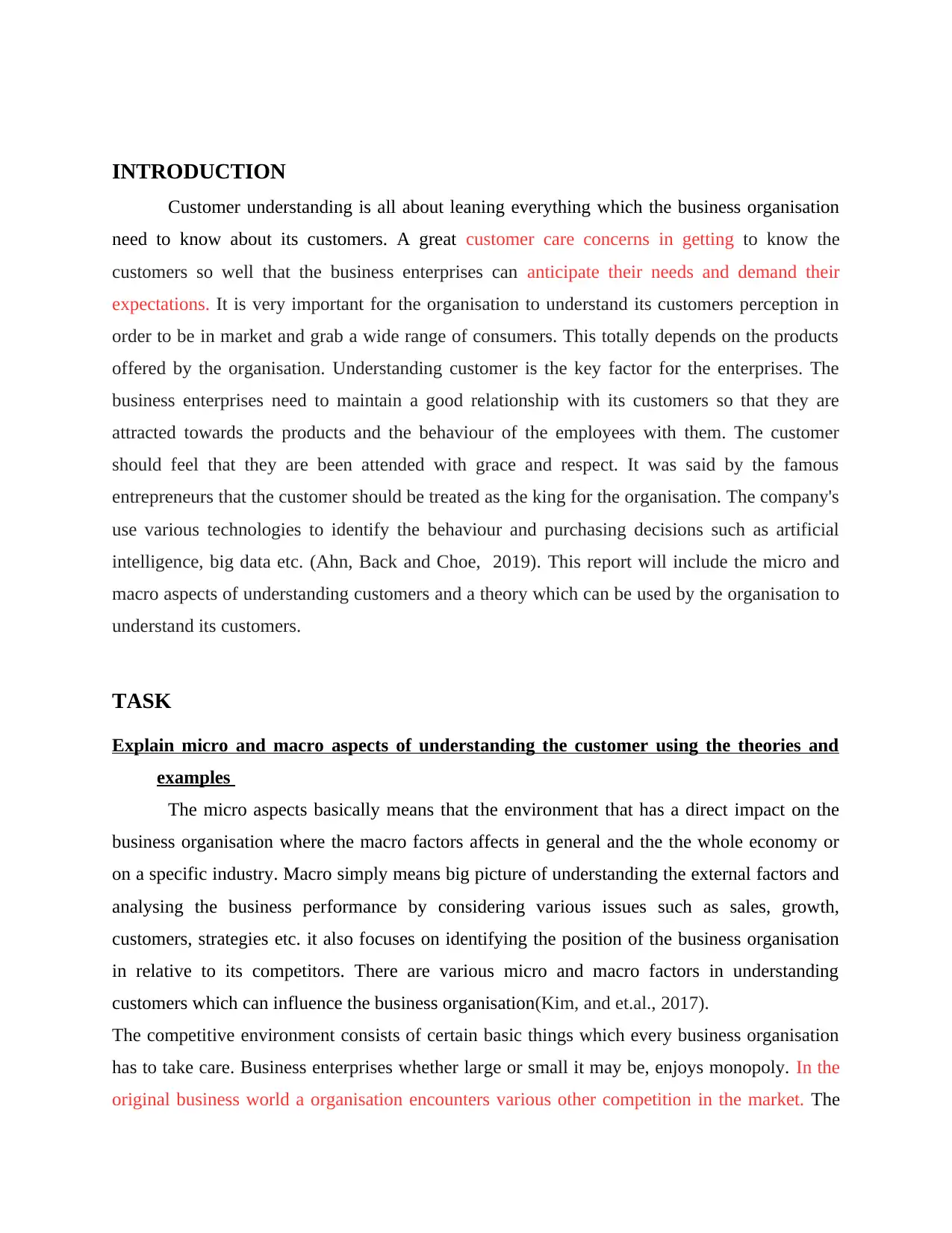
INTRODUCTION
Customer understanding is all about leaning everything which the business organisation
need to know about its customers. A great customer care concerns in getting to know the
customers so well that the business enterprises can anticipate their needs and demand their
expectations. It is very important for the organisation to understand its customers perception in
order to be in market and grab a wide range of consumers. This totally depends on the products
offered by the organisation. Understanding customer is the key factor for the enterprises. The
business enterprises need to maintain a good relationship with its customers so that they are
attracted towards the products and the behaviour of the employees with them. The customer
should feel that they are been attended with grace and respect. It was said by the famous
entrepreneurs that the customer should be treated as the king for the organisation. The company's
use various technologies to identify the behaviour and purchasing decisions such as artificial
intelligence, big data etc. (Ahn, Back and Choe, 2019). This report will include the micro and
macro aspects of understanding customers and a theory which can be used by the organisation to
understand its customers.
TASK
Explain micro and macro aspects of understanding the customer using the theories and
examples
The micro aspects basically means that the environment that has a direct impact on the
business organisation where the macro factors affects in general and the the whole economy or
on a specific industry. Macro simply means big picture of understanding the external factors and
analysing the business performance by considering various issues such as sales, growth,
customers, strategies etc. it also focuses on identifying the position of the business organisation
in relative to its competitors. There are various micro and macro factors in understanding
customers which can influence the business organisation(Kim, and et.al., 2017).
The competitive environment consists of certain basic things which every business organisation
has to take care. Business enterprises whether large or small it may be, enjoys monopoly. In the
original business world a organisation encounters various other competition in the market. The
Customer understanding is all about leaning everything which the business organisation
need to know about its customers. A great customer care concerns in getting to know the
customers so well that the business enterprises can anticipate their needs and demand their
expectations. It is very important for the organisation to understand its customers perception in
order to be in market and grab a wide range of consumers. This totally depends on the products
offered by the organisation. Understanding customer is the key factor for the enterprises. The
business enterprises need to maintain a good relationship with its customers so that they are
attracted towards the products and the behaviour of the employees with them. The customer
should feel that they are been attended with grace and respect. It was said by the famous
entrepreneurs that the customer should be treated as the king for the organisation. The company's
use various technologies to identify the behaviour and purchasing decisions such as artificial
intelligence, big data etc. (Ahn, Back and Choe, 2019). This report will include the micro and
macro aspects of understanding customers and a theory which can be used by the organisation to
understand its customers.
TASK
Explain micro and macro aspects of understanding the customer using the theories and
examples
The micro aspects basically means that the environment that has a direct impact on the
business organisation where the macro factors affects in general and the the whole economy or
on a specific industry. Macro simply means big picture of understanding the external factors and
analysing the business performance by considering various issues such as sales, growth,
customers, strategies etc. it also focuses on identifying the position of the business organisation
in relative to its competitors. There are various micro and macro factors in understanding
customers which can influence the business organisation(Kim, and et.al., 2017).
The competitive environment consists of certain basic things which every business organisation
has to take care. Business enterprises whether large or small it may be, enjoys monopoly. In the
original business world a organisation encounters various other competition in the market. The
⊘ This is a preview!⊘
Do you want full access?
Subscribe today to unlock all pages.

Trusted by 1+ million students worldwide
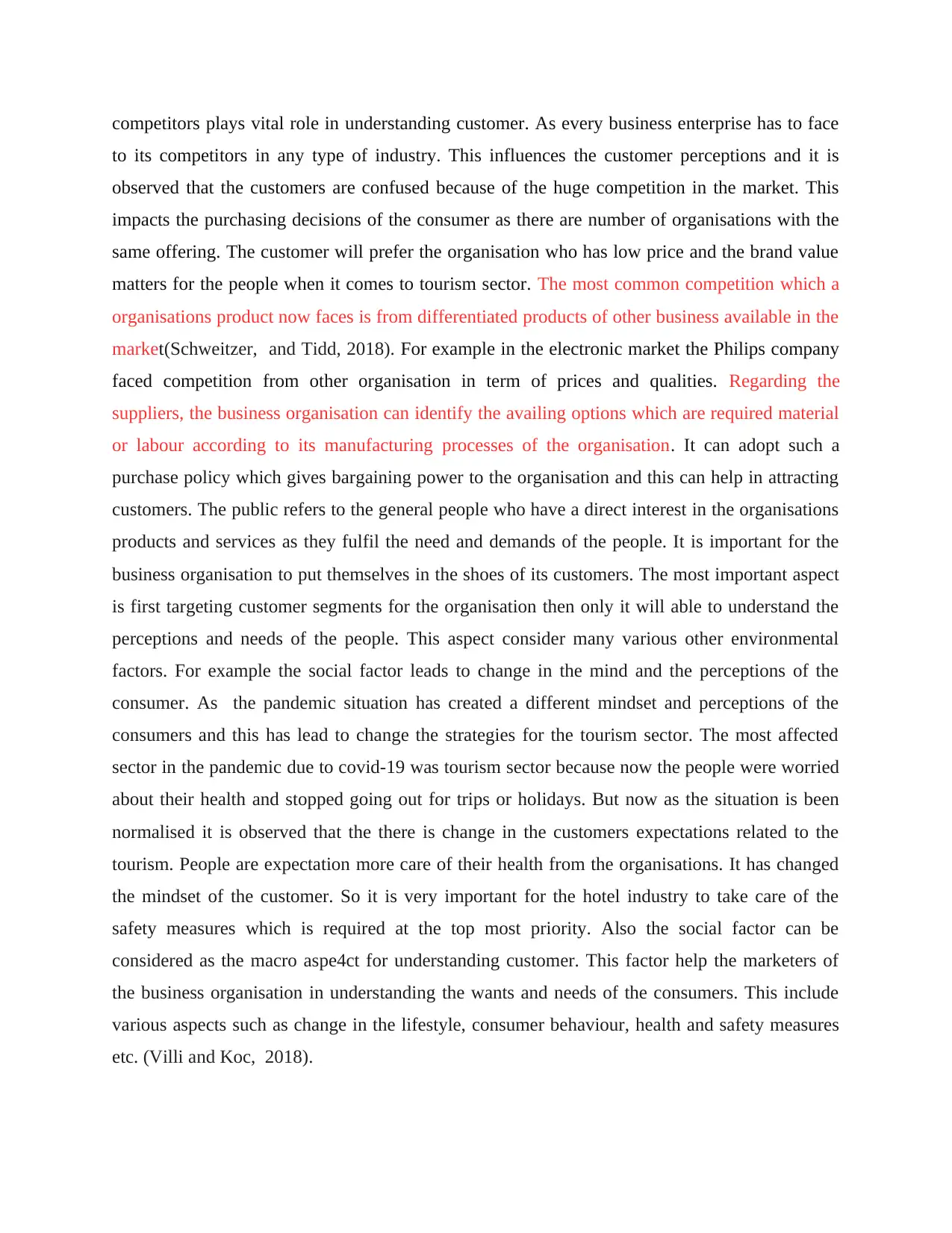
competitors plays vital role in understanding customer. As every business enterprise has to face
to its competitors in any type of industry. This influences the customer perceptions and it is
observed that the customers are confused because of the huge competition in the market. This
impacts the purchasing decisions of the consumer as there are number of organisations with the
same offering. The customer will prefer the organisation who has low price and the brand value
matters for the people when it comes to tourism sector. The most common competition which a
organisations product now faces is from differentiated products of other business available in the
market(Schweitzer, and Tidd, 2018). For example in the electronic market the Philips company
faced competition from other organisation in term of prices and qualities. Regarding the
suppliers, the business organisation can identify the availing options which are required material
or labour according to its manufacturing processes of the organisation. It can adopt such a
purchase policy which gives bargaining power to the organisation and this can help in attracting
customers. The public refers to the general people who have a direct interest in the organisations
products and services as they fulfil the need and demands of the people. It is important for the
business organisation to put themselves in the shoes of its customers. The most important aspect
is first targeting customer segments for the organisation then only it will able to understand the
perceptions and needs of the people. This aspect consider many various other environmental
factors. For example the social factor leads to change in the mind and the perceptions of the
consumer. As the pandemic situation has created a different mindset and perceptions of the
consumers and this has lead to change the strategies for the tourism sector. The most affected
sector in the pandemic due to covid-19 was tourism sector because now the people were worried
about their health and stopped going out for trips or holidays. But now as the situation is been
normalised it is observed that the there is change in the customers expectations related to the
tourism. People are expectation more care of their health from the organisations. It has changed
the mindset of the customer. So it is very important for the hotel industry to take care of the
safety measures which is required at the top most priority. Also the social factor can be
considered as the macro aspe4ct for understanding customer. This factor help the marketers of
the business organisation in understanding the wants and needs of the consumers. This include
various aspects such as change in the lifestyle, consumer behaviour, health and safety measures
etc. (Villi and Koc, 2018).
to its competitors in any type of industry. This influences the customer perceptions and it is
observed that the customers are confused because of the huge competition in the market. This
impacts the purchasing decisions of the consumer as there are number of organisations with the
same offering. The customer will prefer the organisation who has low price and the brand value
matters for the people when it comes to tourism sector. The most common competition which a
organisations product now faces is from differentiated products of other business available in the
market(Schweitzer, and Tidd, 2018). For example in the electronic market the Philips company
faced competition from other organisation in term of prices and qualities. Regarding the
suppliers, the business organisation can identify the availing options which are required material
or labour according to its manufacturing processes of the organisation. It can adopt such a
purchase policy which gives bargaining power to the organisation and this can help in attracting
customers. The public refers to the general people who have a direct interest in the organisations
products and services as they fulfil the need and demands of the people. It is important for the
business organisation to put themselves in the shoes of its customers. The most important aspect
is first targeting customer segments for the organisation then only it will able to understand the
perceptions and needs of the people. This aspect consider many various other environmental
factors. For example the social factor leads to change in the mind and the perceptions of the
consumer. As the pandemic situation has created a different mindset and perceptions of the
consumers and this has lead to change the strategies for the tourism sector. The most affected
sector in the pandemic due to covid-19 was tourism sector because now the people were worried
about their health and stopped going out for trips or holidays. But now as the situation is been
normalised it is observed that the there is change in the customers expectations related to the
tourism. People are expectation more care of their health from the organisations. It has changed
the mindset of the customer. So it is very important for the hotel industry to take care of the
safety measures which is required at the top most priority. Also the social factor can be
considered as the macro aspe4ct for understanding customer. This factor help the marketers of
the business organisation in understanding the wants and needs of the consumers. This include
various aspects such as change in the lifestyle, consumer behaviour, health and safety measures
etc. (Villi and Koc, 2018).
Paraphrase This Document
Need a fresh take? Get an instant paraphrase of this document with our AI Paraphraser
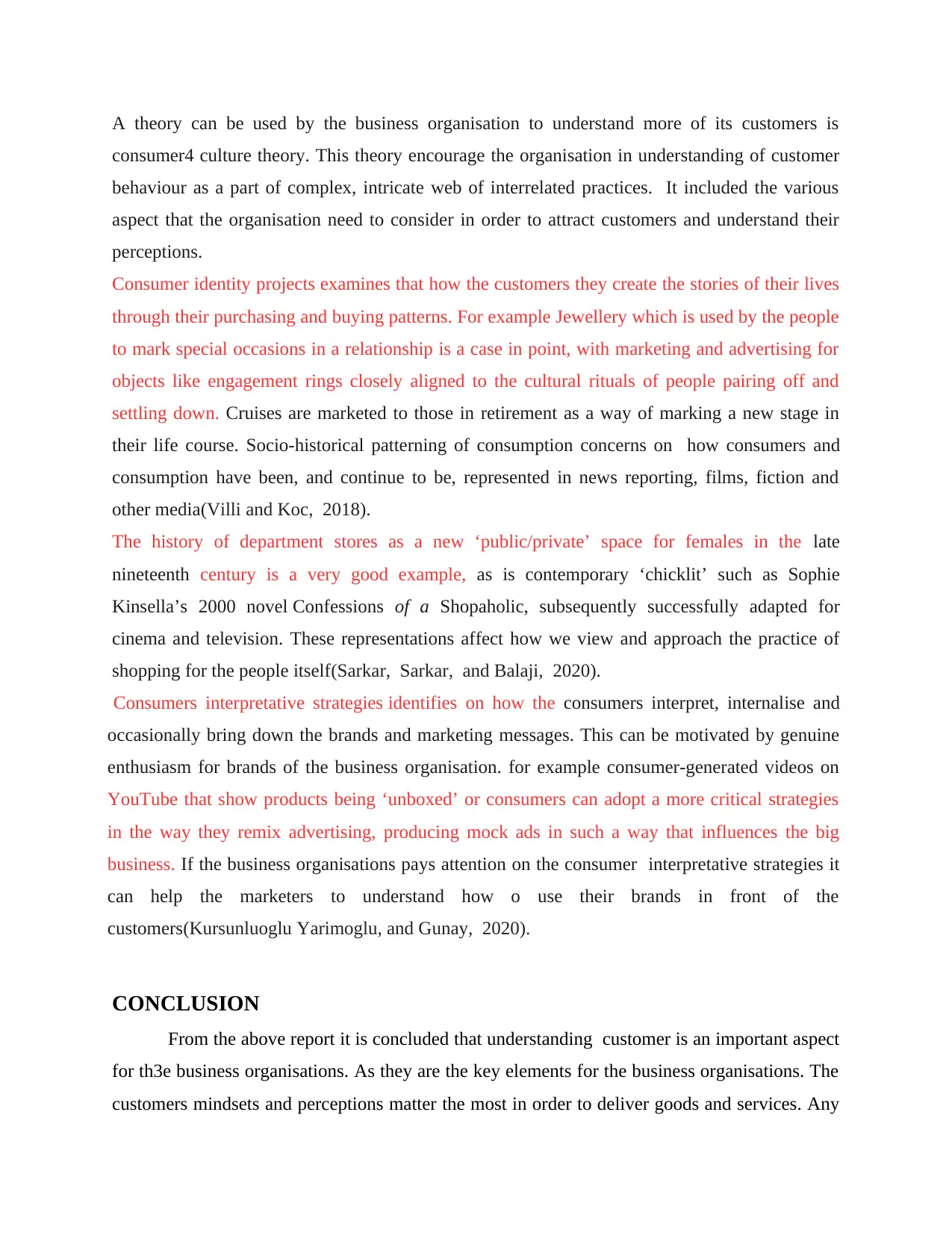
A theory can be used by the business organisation to understand more of its customers is
consumer4 culture theory. This theory encourage the organisation in understanding of customer
behaviour as a part of complex, intricate web of interrelated practices. It included the various
aspect that the organisation need to consider in order to attract customers and understand their
perceptions.
Consumer identity projects examines that how the customers they create the stories of their lives
through their purchasing and buying patterns. For example Jewellery which is used by the people
to mark special occasions in a relationship is a case in point, with marketing and advertising for
objects like engagement rings closely aligned to the cultural rituals of people pairing off and
settling down. Cruises are marketed to those in retirement as a way of marking a new stage in
their life course. Socio-historical patterning of consumption concerns on how consumers and
consumption have been, and continue to be, represented in news reporting, films, fiction and
other media(Villi and Koc, 2018).
The history of department stores as a new ‘public/private’ space for females in the late
nineteenth century is a very good example, as is contemporary ‘chicklit’ such as Sophie
Kinsella’s 2000 novel Confessions of a Shopaholic, subsequently successfully adapted for
cinema and television. These representations affect how we view and approach the practice of
shopping for the people itself(Sarkar, Sarkar, and Balaji, 2020).
Consumers interpretative strategies identifies on how the consumers interpret, internalise and
occasionally bring down the brands and marketing messages. This can be motivated by genuine
enthusiasm for brands of the business organisation. for example consumer-generated videos on
YouTube that show products being ‘unboxed’ or consumers can adopt a more critical strategies
in the way they remix advertising, producing mock ads in such a way that influences the big
business. If the business organisations pays attention on the consumer interpretative strategies it
can help the marketers to understand how o use their brands in front of the
customers(Kursunluoglu Yarimoglu, and Gunay, 2020).
CONCLUSION
From the above report it is concluded that understanding customer is an important aspect
for th3e business organisations. As they are the key elements for the business organisations. The
customers mindsets and perceptions matter the most in order to deliver goods and services. Any
consumer4 culture theory. This theory encourage the organisation in understanding of customer
behaviour as a part of complex, intricate web of interrelated practices. It included the various
aspect that the organisation need to consider in order to attract customers and understand their
perceptions.
Consumer identity projects examines that how the customers they create the stories of their lives
through their purchasing and buying patterns. For example Jewellery which is used by the people
to mark special occasions in a relationship is a case in point, with marketing and advertising for
objects like engagement rings closely aligned to the cultural rituals of people pairing off and
settling down. Cruises are marketed to those in retirement as a way of marking a new stage in
their life course. Socio-historical patterning of consumption concerns on how consumers and
consumption have been, and continue to be, represented in news reporting, films, fiction and
other media(Villi and Koc, 2018).
The history of department stores as a new ‘public/private’ space for females in the late
nineteenth century is a very good example, as is contemporary ‘chicklit’ such as Sophie
Kinsella’s 2000 novel Confessions of a Shopaholic, subsequently successfully adapted for
cinema and television. These representations affect how we view and approach the practice of
shopping for the people itself(Sarkar, Sarkar, and Balaji, 2020).
Consumers interpretative strategies identifies on how the consumers interpret, internalise and
occasionally bring down the brands and marketing messages. This can be motivated by genuine
enthusiasm for brands of the business organisation. for example consumer-generated videos on
YouTube that show products being ‘unboxed’ or consumers can adopt a more critical strategies
in the way they remix advertising, producing mock ads in such a way that influences the big
business. If the business organisations pays attention on the consumer interpretative strategies it
can help the marketers to understand how o use their brands in front of the
customers(Kursunluoglu Yarimoglu, and Gunay, 2020).
CONCLUSION
From the above report it is concluded that understanding customer is an important aspect
for th3e business organisations. As they are the key elements for the business organisations. The
customers mindsets and perceptions matter the most in order to deliver goods and services. Any
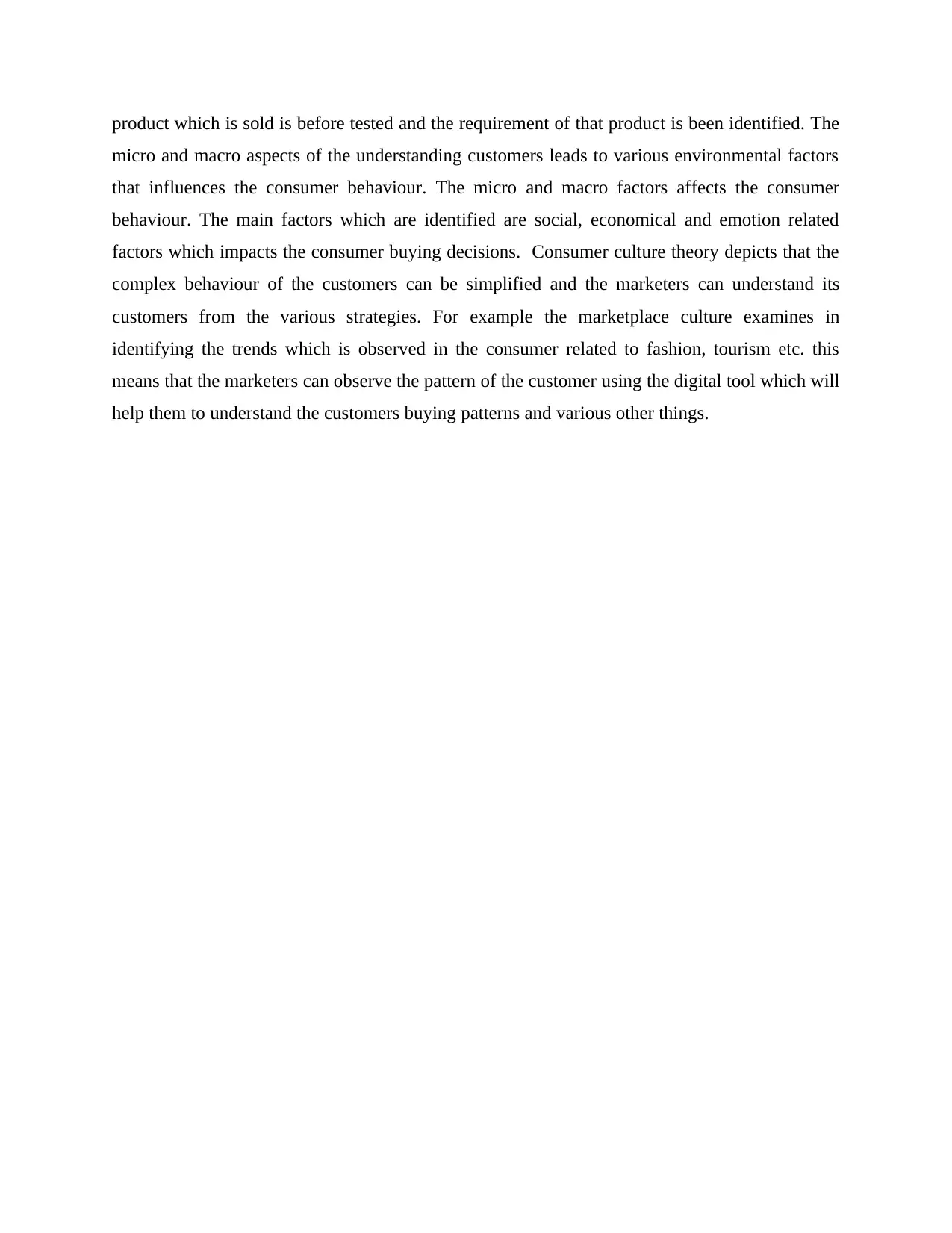
product which is sold is before tested and the requirement of that product is been identified. The
micro and macro aspects of the understanding customers leads to various environmental factors
that influences the consumer behaviour. The micro and macro factors affects the consumer
behaviour. The main factors which are identified are social, economical and emotion related
factors which impacts the consumer buying decisions. Consumer culture theory depicts that the
complex behaviour of the customers can be simplified and the marketers can understand its
customers from the various strategies. For example the marketplace culture examines in
identifying the trends which is observed in the consumer related to fashion, tourism etc. this
means that the marketers can observe the pattern of the customer using the digital tool which will
help them to understand the customers buying patterns and various other things.
micro and macro aspects of the understanding customers leads to various environmental factors
that influences the consumer behaviour. The micro and macro factors affects the consumer
behaviour. The main factors which are identified are social, economical and emotion related
factors which impacts the consumer buying decisions. Consumer culture theory depicts that the
complex behaviour of the customers can be simplified and the marketers can understand its
customers from the various strategies. For example the marketplace culture examines in
identifying the trends which is observed in the consumer related to fashion, tourism etc. this
means that the marketers can observe the pattern of the customer using the digital tool which will
help them to understand the customers buying patterns and various other things.
⊘ This is a preview!⊘
Do you want full access?
Subscribe today to unlock all pages.

Trusted by 1+ million students worldwide
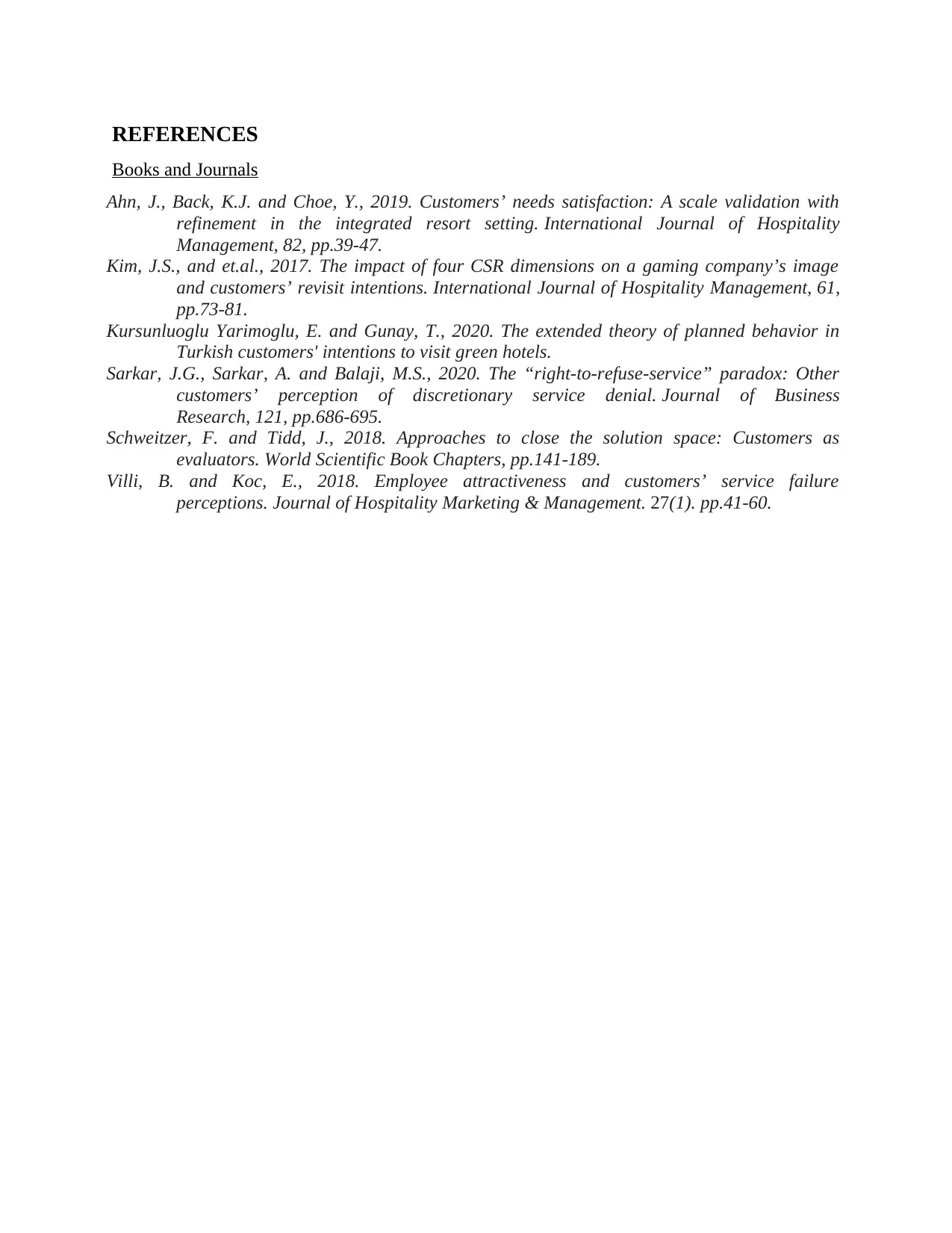
REFERENCES
Books and Journals
Ahn, J., Back, K.J. and Choe, Y., 2019. Customers’ needs satisfaction: A scale validation with
refinement in the integrated resort setting. International Journal of Hospitality
Management, 82, pp.39-47.
Kim, J.S., and et.al., 2017. The impact of four CSR dimensions on a gaming company’s image
and customers’ revisit intentions. International Journal of Hospitality Management, 61,
pp.73-81.
Kursunluoglu Yarimoglu, E. and Gunay, T., 2020. The extended theory of planned behavior in
Turkish customers' intentions to visit green hotels.
Sarkar, J.G., Sarkar, A. and Balaji, M.S., 2020. The “right-to-refuse-service” paradox: Other
customers’ perception of discretionary service denial. Journal of Business
Research, 121, pp.686-695.
Schweitzer, F. and Tidd, J., 2018. Approaches to close the solution space: Customers as
evaluators. World Scientific Book Chapters, pp.141-189.
Villi, B. and Koc, E., 2018. Employee attractiveness and customers’ service failure
perceptions. Journal of Hospitality Marketing & Management. 27(1). pp.41-60.
Books and Journals
Ahn, J., Back, K.J. and Choe, Y., 2019. Customers’ needs satisfaction: A scale validation with
refinement in the integrated resort setting. International Journal of Hospitality
Management, 82, pp.39-47.
Kim, J.S., and et.al., 2017. The impact of four CSR dimensions on a gaming company’s image
and customers’ revisit intentions. International Journal of Hospitality Management, 61,
pp.73-81.
Kursunluoglu Yarimoglu, E. and Gunay, T., 2020. The extended theory of planned behavior in
Turkish customers' intentions to visit green hotels.
Sarkar, J.G., Sarkar, A. and Balaji, M.S., 2020. The “right-to-refuse-service” paradox: Other
customers’ perception of discretionary service denial. Journal of Business
Research, 121, pp.686-695.
Schweitzer, F. and Tidd, J., 2018. Approaches to close the solution space: Customers as
evaluators. World Scientific Book Chapters, pp.141-189.
Villi, B. and Koc, E., 2018. Employee attractiveness and customers’ service failure
perceptions. Journal of Hospitality Marketing & Management. 27(1). pp.41-60.
1 out of 7
Related Documents
Your All-in-One AI-Powered Toolkit for Academic Success.
+13062052269
info@desklib.com
Available 24*7 on WhatsApp / Email
![[object Object]](/_next/static/media/star-bottom.7253800d.svg)
Unlock your academic potential
Copyright © 2020–2025 A2Z Services. All Rights Reserved. Developed and managed by ZUCOL.

